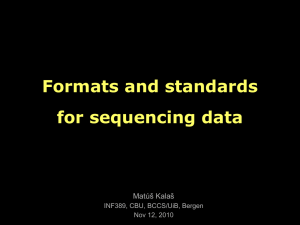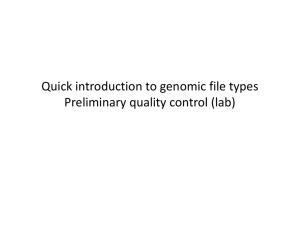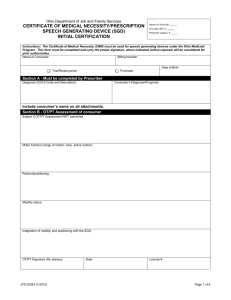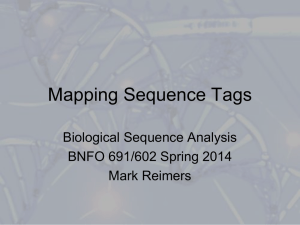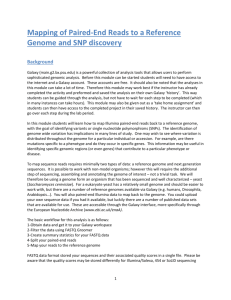Sequence Alignment Guidelines for 1000 bull genomes project
advertisement
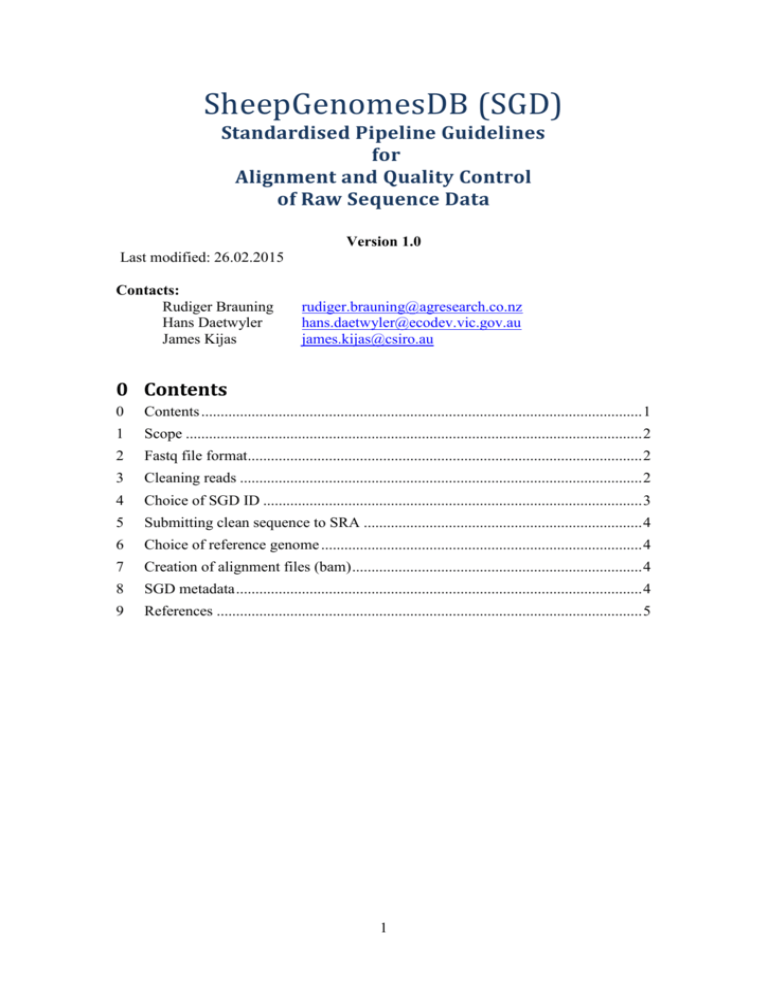
SheepGenomesDB (SGD) Standardised Pipeline Guidelines for Alignment and Quality Control of Raw Sequence Data Version 1.0 Last modified: 26.02.2015 Contacts: Rudiger Brauning Hans Daetwyler James Kijas rudiger.brauning@agresearch.co.nz hans.daetwyler@ecodev.vic.gov.au james.kijas@csiro.au 0 Contents 0 Contents .................................................................................................................. 1 1 Scope ...................................................................................................................... 2 2 Fastq file format...................................................................................................... 2 3 Cleaning reads ........................................................................................................ 2 4 Choice of SGD ID .................................................................................................. 3 5 Submitting clean sequence to SRA ........................................................................ 4 6 Choice of reference genome ................................................................................... 4 7 Creation of alignment files (bam) ........................................................................... 4 8 SGD metadata ......................................................................................................... 4 9 References .............................................................................................................. 5 1 1 Scope This document describes how to go from raw fastq files (sequence data) to cleaned bam files (sequence aligned against the reference genome). It also describes what additional information has to accompany a bam file in order for it to be considered for the SheepGenomesDB (SGD). The SGD is a project of the International Sheep Genomics Consortium. Periodically we will perform variant calling on all the aligned animals available. The resulting vcf files, together with metadata will then be submitted to the European Variation Archive (EVA) at Ensembl. 2 Fastq file format We require Illumina 1.8 (Phred+33) as fastq file format. For Illumina users, CASAVA version 1.8 produces fastq files with quality score as ASCII qscores Phred+33 encoded. If your data is from an older version of CASAVA and therefore Phred+64 encoded you can use the –I option when performing alignments with bwa aln to convert the ASCII qscores to Phred+33 encoding (this option is not available with bwa mem). Alternatively you can use seqtk to convert the qscores prior to alignment. For an overview of different fastq formats see http://en.wikipedia.org/wiki/FASTQ_format Note: In the interest of quality control please do not merge fastq files across different lanes or flowcells. 3 Cleaning reads We highly recommend checking raw and filtered sequence reads using FastQC or equivalent. The following sequential set of filters will reduce the number of false positive variants called from sequence pileups and must be performed on fastq files prior to alignment. We recommend running quadtrim with option –d bulls, which performs the above 2 filtering steps on Illumina data. We also recommend bio-stream-tools which contain nextseq-trim for trimming strings of A and/or G from 3’ end of NextSeq reads. Further information can be requested from Amanda Chamberlain at amanda.chamberlain@ecodev.vic.gov.au. 1. Remove Illumina reads that do not pass Chastity filter. To check look at the read names, there should be an “N” present in the second field of the sequence ID line for “not filtered out” (@D00390:213:C4TY8ACXX:5:1101:2068:2113 1:N:0:4). 2. Remove adaptor sequence from reads. 3. Trim low quality bases (Phred score less than 20) from 5’ and 3’ ends. 4. Discard reads with a mean Phred score below 20. 5. Remove reads which have 3 or more N in the sequence. 6. Remove known artefacts. Reads from Illumina’s NextSeq machines are known to have strings of A and/or G 3’. These strings have normal qscores but are nothing more than artefacts. 7. Discard reads that are too short (less than 50% of their original length). Note: Where a read is left unpaired because its mate did not meet the required quality level, the orphaned read can still be aligned as a single ended read. 4 Choice of SGD ID To facilitate collaborative use of animal data while retaining some level of privacy we require a SGD ID to be chosen for each of your animals. This ID looks like the following: <country of origin>_<breed>_<gender>_<number> A New Zealand texel ewe with number 12345 would have an SGD ID of NZ_TXL_F_000000012345. Build your SGD ID step by step: 1. For two letter country codes see http://en.wikipedia.org/wiki/ISO_31661_alpha-2 2. Breed abbreviations can be found on sheepgenomesdb.org There are several scenarios: a) Main breed component (e.g. ROM) >=70% Suggestion: <ROM>, record other breed components as metadata b) Main breed component <50% (e.g. 50% Romney, 25% East Friesian, 25% Texel) Suggestion: <CMP>, record other breed components as metadata. <CMP> stands for ‘composite’. c) Composites with special names, e.g. Primera, Highlander Suggestion: <CMP>, record special name and breed components as metadata d) Breed unknown Suggestion: <UNK> 3. For gender choose between F and M. 4. Finally choose a number (this could e.g. be a national ID) to complete the SGD ID. Zero fill this number to make up 12 digits. 5. To ensure uniqueness of SGD IDs please send your desired SGD IDs to one of the contacts listed above. 3 5 Submitting clean sequence to SRA We recommend submitting your clean fastq sequences to NCBI’s Sequence Read Archive (SRA). 6 Choice of reference genome Oar_v3.1 from Ensembl is the strongly preferred reference genome file. Standardising the reference file across all collaborators ensures minimal issues with combining the data. The reference genome can be downloaded from ftp://ftp.ensembl.org/pub/release78/fasta/ovis_aries/dna/Ovis_aries.Oar_v3.1.dna_sm.toplevel.fa.gz The reference genome contains the 26 autosomes, the X chromosome, the unassigned scaffolds, and the mitochondrial genome. We encourage you to compare the checksum of the downloaded file with the checksum provided at Ensembl (ftp://ftp.ensembl.org/pub/release-78/fasta/ovis_aries/dna/CHECKSUMS). Hint: use the UNIX sum command. Note: While the sequence data for Oar_v3.1 is identical across Ensembl, NCBI, and UCSC, the contig names are not. Each site requires their particular naming scheme for things to work with their genome browsers or variant effect predictors. 7 Creation of alignment files (bam) Please follow the steps below to get to a single bam file per animal: 1. Choose correct reference genome (described above). 2. Align fastq files to reference using bwa mem 0.5.9+ with default parameters. bwa mem is faster and more accurate than bwa aln. Reads have to be at least 70bp in length for bwa mem. 3. Within bwa mem use –M to ensure Picard compatibility. 4. Within bwa use –R to set RG headers, ensuring that sample (SM) field contains the SGD ID. 5. Do not filter alignments by mapping quality. We will do that when we call variants. 6. Merge bam files where they correspond to the same individual. This can be done with MergeSamFiles (picard). Ensure the SGD ID is in the final bam file name.Remove or mark PCR duplicates. This can be done using rmdup (samtools) or MarkDuplicates (picard). 7. Perform a local realignment around indels to minimise mismatches across all reads. This can be done with the GATK tools RealignerTargetCreator and IndelRealigner. 8. If you haven’t performed step 4 (specifying SM field in RG header lines as SGD ID), fix this now using samtools reheader. 9. Sort alignments in order of correct reference genome (described above). 10. Create index files (.bai). 11. Calculate the final mean coverage of the alignment. This can be done using DepthOfCoverage (GATK). Include coverage statistics in the metadata list (described below). 8 SGD metadata Metadata provides information on the animals and is essential to the use of the SGD. The minimum information required is: 4 Breed country Breed Gender SGD ID Contributor (name, institution, address, email) The recommended additional information is: Animal o NCBI’s Biosamples ID (if available) o Tissue, e.g. blood o National ID (if available) o Aliases o Age o Year of birth o Country o GPS location coordinates o Health o Picture Sequencing o Platform, e.g. Illumina HiSeq 2500 o Version, e.g. v4 chemistry o SRA accession number (if available) o DNA extraction method (high salt, filter, magnetic beads) o Mean coverage depth Analysis o Software, software version, commands Genotypes o Pointer to other genotype information for this animal, e.g. HD SNP chip results Funding o Keep your funding agency happy and mention them here It’s not a problem to include additional categories, in fact this is encouraged. 9 References bio-stream-tools https://bitbucket.org/arobinson/bio-stream-tools/overview bwa Li H and Durbin R (2009) Fast and accurate short read alignment with Burrows-Wheeler Transform. Bioinformatics, 25:1754-60. FastQC http://www.bioinformatics.babraham.ac.uk/projects/fastqc/ GATK Depristo MA, Banks E, Poplin R, Garimella KV, Maguire JR, Hartl C, Philippakis AA, Del Angel G, Rivas MA, Hanna M, McKenna A, Fennell TJ, Kernytsky AM, Sivachenko AY, Cibulskis K, Gabriel SB, Altshuler D, Daly MJ (2011) A framework for variation discovery and genotyping using nextgeneration DNA sequencing data. Nature Genetics 43, 491–498. doi:10.1038/ng.806 5 picard http://picard.sourceforge.net/index.shtml quadtrim https://bitbucket.org/arobinson/quadtrim samtools Li H, Handsaker B, Wysoker A, Fennell T, Ruan J, Homer N, Marth G, Abecasis G, Durbin R and 1000 Genome Project Data Processing Subgroup (2009) The Sequence alignment/map (SAM) format and SAMtools. Bioinformatics, 25, 2078-9. seqtk https://github.com/lh3/seqtk 6
